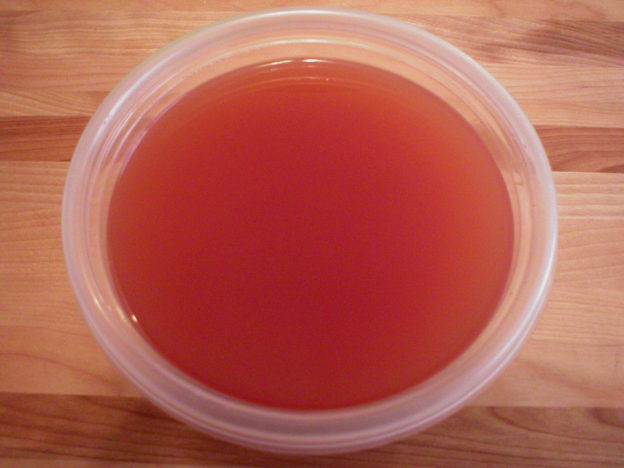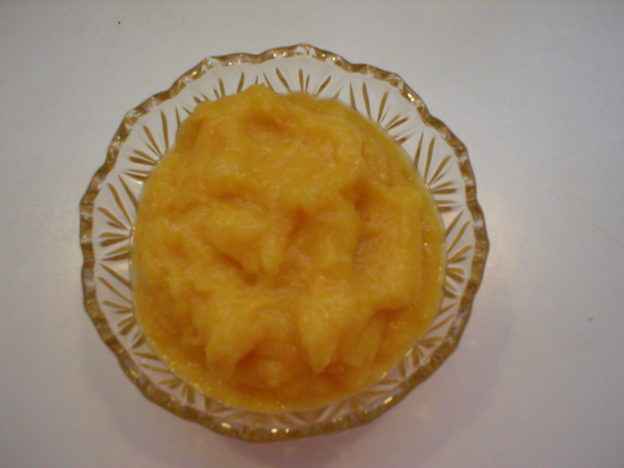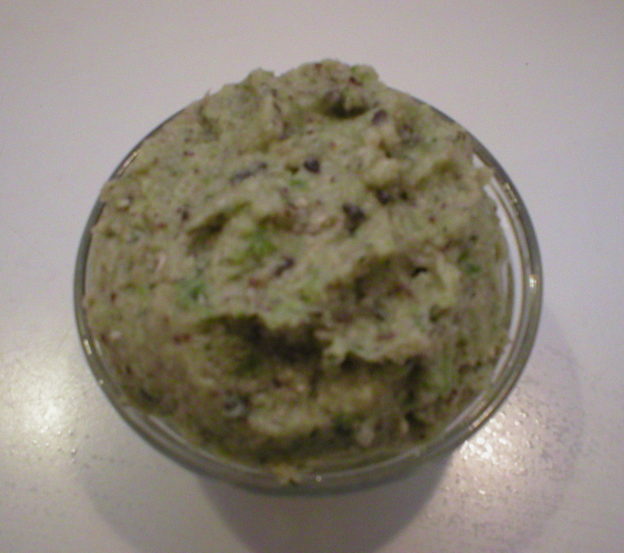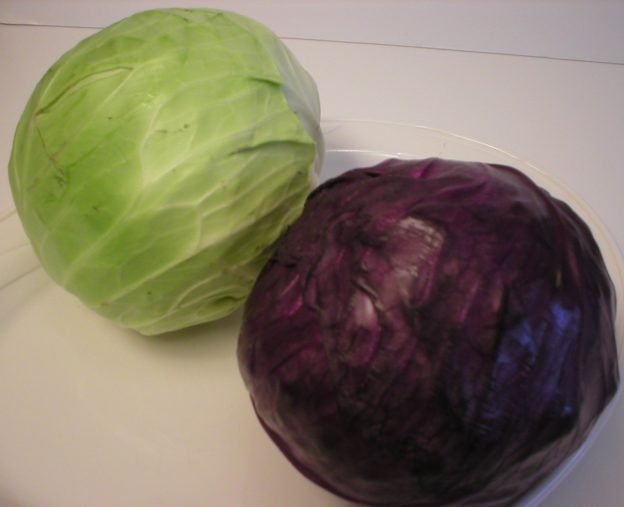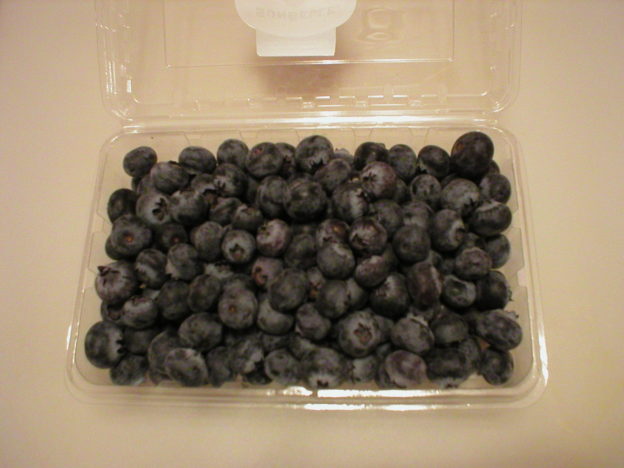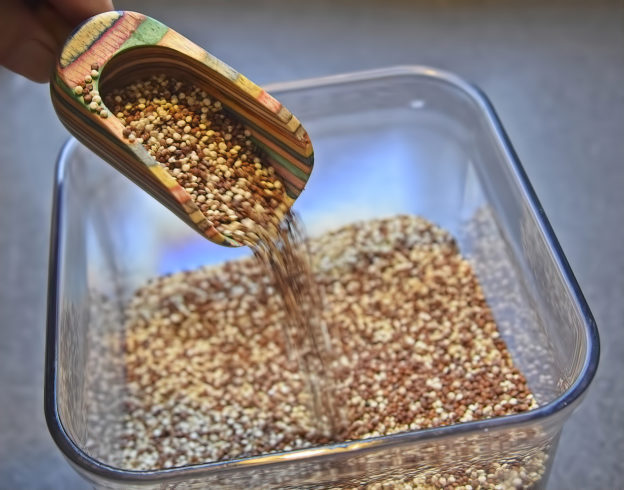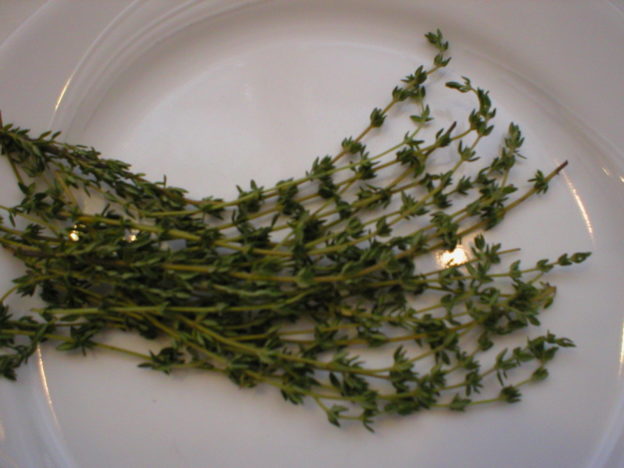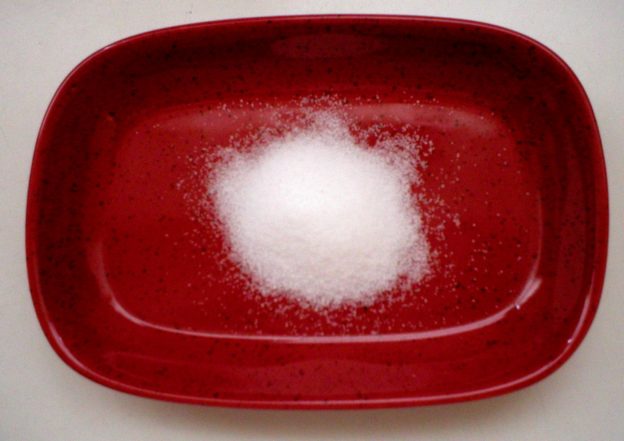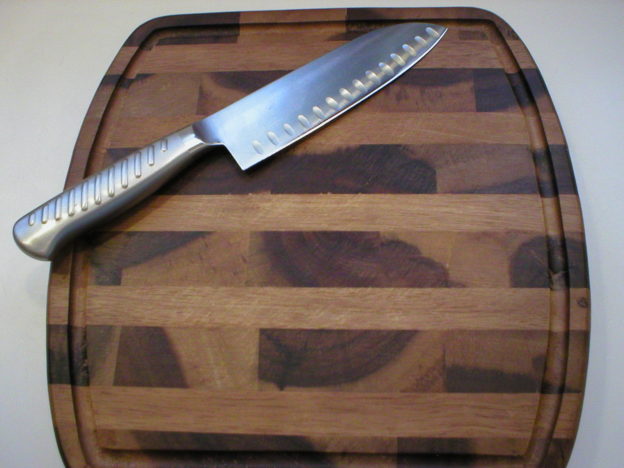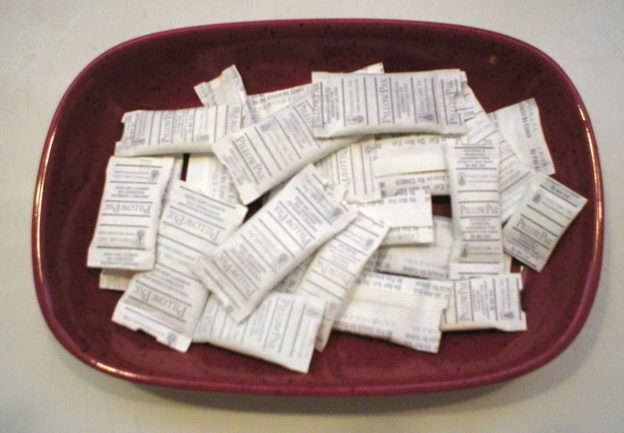The current 2015-2020 Dietary Guidelines for Americans recommend that Americans consume less than 2300 mg of sodium a day. That equates to less than one teaspoon of salt. Yet, many Americans still consume a lot more than that. Furthermore, recommendations are moving toward reducing that amount even more, to 1500 mg per day (about 2/3 of a teaspoon of salt, and this does not account for naturally-occurring sodium in our food). Where does all this sodium come from? In the average American diet, about 77% comes from processed foods or foods prepared outside the home (such as restaurant meals), 12% comes from natural sources (naturally occurring sodium in foods), 6% from salt added at the table while eating, and 5% added while cooking. When examining those percentages, it’s clear that most of the sodium in our diet comes from foods that we did not prepare ourselves.
We do need some sodium for our bodies to function normally, but the amount is far less than we consume. A mere 186 mg of sodium per day is all that’s truly needed, and that small amount can be found naturally occurring in whole, unadulterated foods. Furthermore, consuming whole, unadulterated plant foods such as fruits and vegetables, provides an abundance of potassium, helping to balance the potassium to sodium ratio in the body.
Many people need (or want) to slash their salt intake for numerous reasons and struggle to do so. The following are some suggestions on how to reduce your sodium intake, balance the sodium to potassium ratio, and yet still enjoy the flavor of our foods.
Prepare Your Own Foods at Home
This may hard to do all the time, especially if you travel a lot in your career, have odd working hours or a lot of responsibilities with little time to spend in the kitchen. You’re forgiven! However, it’s up to you to work out a way to squeeze a little valuable time for yourself to prepare some of your own foods to take along with you so you can reduce your need for restaurant foods.
Here are some ideas for easy food preparation at home…
* Try overnight oats for a ready-to-go breakfast in the morning. Recipes are all over the internet!
* Take time on a day off to prepare foods ahead for the coming week. Many people spend time on the weekend making a lot of food for the coming week’s lunches. Pack them in individual serving containers so you can just grab one and put it into a travel bag with an ice pack on your way out the door. It’ll be ready when you are. If need be, they could be stored in the freezer and placed in the refrigerator the night before you need it so it can thaw safely.
* Plan on having a large salad once a day, or at least as often as you can. Lettuce can be washed in advanced, drained, and then stored in the refrigerator in a covered container between layers of paper towels. It will stay crisp and will be ready when needed. Other vegetables can also be washed and cut in advance and stored in a similar way. Just be sure they’re not stored overly wet, or sitting in a puddle of water, which could cause them to spoil.
* Make a large pot of soup on a day off. Chill it down well, then store it in the refrigerator, either in a large container, or in individual containers. It can also be frozen in individual serving size containers for an easy lunch or supper when needed. If you remember, transfer a container (for the next day) in the refrigerator the night before so it can thaw (or at least start to thaw). Warm the soup on the stove or in the microwave for a fast meal.
* Make sandwich filling of some sort on a day off. Homemade hummus, nut butter and fruit spread, or (if you’re an omnivore) cooked meat or a meat combo if you prefer, are all possible sandwich fillings where you can control what’s in them. Store the filling in a covered container in the refrigerator and sandwiches will be easy to make when you need them.
* Make a large casserole on your day off. Like the soup, salads, and sandwich fillings, making a large casserole ahead of time gives you a nice option of your own foods made to your liking that you can enjoy during the week and have ready when you are. Individual portions can be stored in the refrigerator or frozen until needed. Warming it in a microwave or even toaster oven is an option, as long as your container is appropriate for those methods.
* Put supper in the crock pot/slow cooker in the morning before you leave for work. This may not work for everyone, since it involves extra time in the morning. But if you can get up a little earlier or work it out, a nice, hot, homemade supper will be ready for you when you get home. How convenient is that?
Season Foods with Herbs or Spices Instead of Salt
Sometimes a little added salt goes a long way in making food palatable, and that should be OK as long as we don’t overdo it (or have a medical issue requiring a salt-free diet). However, seasoning our own food with plenty of herbs and spices can reduce our need for added salt. Try some of the following options to flavor your foods instead of salt…
Proteins, Beans, Legumes, and Marinades: Basil, chiles/cayenne, chives, cilantro, coriander, dill (weed), ginger, nutmeg, oregano, paprika, pepper, rosemary, sage, tarragon, thyme, turmeric
Vegetables, Stir-Fries, Salads: Basil, chiles/cayenne, chives, cinnamon, cilantro, coriander, dill (weed), ginger, mint, nutmeg, oregano, paprika, pepper, rosemary, sage, tarragon, thyme, turmeric
Fruits: Cardamom, cinnamon, coriander, ginger, mint, nutmeg, pepper, rosemary, tarragon (esp. with lemon), thyme (esp. with citrus)
Grains, Grain Products, and Grain Dishes: Basil, cardamom, cinnamon, cloves, chiles/cayenne, coriander, ginger, mint, nutmeg, oregano, paprika, rosemary, sage, tarragon, thyme, turmeric
Dairy and Non-Dairy: Cardamom, chives, dill (weed), mint, nutmeg, rosemary, sage, thyme (esp. with cheese)
Casseroles, Sauces, Soups, Stews: Basil, cardamom, chiles/cayenne, chives, cinnamon, cilantro, coriander, dill (weed), ginger, nutmeg, oregano, paprika, pepper, rosemary, tarragon, thyme, turmeric
About some specific herbs/spices used to replace salt…
* Basil. Basil is sweet yet peppery. Fresh basil has more flavor than that of dried. Basil is excellent in pesto, marinades, dressings, sauces, sandwiches, soups, and salads. It is often used in Mediterranean dishes, especially tomato-based sauces and pizzas. There are different varieties of basil, giving different flavors to this herb.
* Cardamom. Cardamom is a warm, aromatic spice. Whole cardamom pods can be used, or the seeds (which are inside the pods) can be used whole or ground. Cardamom is commonly added to Asian spice mixes and curry pastes. It works well in baked goods and sweet breads along with cloves and cinnamon.
* Chiles/Cayenne. Chile peppers vary a lot in their heat, so always add a little at first if you’re not sure. Cayenne is a specific type of Chile pepper. Chile peppers are available fresh, dried, flaked, ground into powder, and made into hot sauce. Hot sauce may be high in sugar and/or salt, so do read labels if you’re on a salt-restricted plan. Opting for fresh hot peppers gives you more control over the sodium content of your food. Chiles work well in most foods, including vegetable and seafood dishes. A pinch of chili pepper with mustard can help you reduce the amount of cheese needed in a cheese sauce (thereby reducing sodium in the sauce, since cheese is high in sodium). Chiles combine well with cumin, coriander seeds, and turmeric. Cayenne pairs well with meats, grains, soups, and vegetables.
* Chives. Chives have an onion-like flavor but are milder than onions. Add chives to hot dishes at the end of cooking to preserve the flavor. Chives are excellent in mashed potatoes, baked potatoes, casseroles, salads, cream cheese, fish and poultry.
* Cinnamon. Cinnamon is most often used in sweet treats and baked goods like cakes, quick breads, and fruit crisps. But cinnamon also works in some savory dishes too. In Turkish and Middle Eastern cuisines, cinnamon is used to flavor chicken and lamb. It can also be used to add a special flavor to curries, tagines, casseroles, roast vegetables, Bolognese sauce, and stewed fruit.
* Coriander/Cilantro. In the United States, we refer to the seeds of this plant as coriander, whereas the leaves are called cilantro. The cilantro leaves have an earthy yet citrusy flavor. The coriander seeds have a warm, spicy, citrus flavor. Cilantro can be used raw or added to hot foods at the end of cooking time to preserve their flavor. The leaves are excellent in salads, soups (esp. carrot and coriander soup), salsas, curries, fish, and chicken dishes. It is often combined with lime and chiles in stir-fry dishes. Coriander seeds are commonly used in Indian cuisine.
* Cumin. The flavor of cumin is earthy and smoky. Cumin is the second most popular spice in the world (whereas black pepper is the first). Cumin pairs well with many foods, but especially chicken, beef, lamb, game, beans and rice. For a Mexican flare, combine cumin with oregano and chili. For a taste of India, combine cumin with cardamom, coriander, and turmeric.
* Dill. Dill seeds and dill weed (the leaves) are both used in a variety of dishes. Their flavor is very different. Dill seeds have a flavor of fennel, star anise, and celery combined. They are what gives dill pickles their characteristic flavor. The leaves (dill weed) have a fresh, bright flavor that add hints of lemon anise. Dill weed blends well with cottage cheese, cream cheese, omelets, seafood, steak, potato salad, and cucumber salads.
* Ginger. Ginger has a sharp aroma and flavor of pepper and lemon. It can be purchased fresh or dried and ground. Ginger enhances both sweet and savory dishes. Grated fresh ginger can be added to stir-fries, rice, curries, and meats. It can be added to salad dressings and even stewed fruit.
* Mint. This refreshing herb works well in both sweet and savory dishes. Try this with salads, pasta or couscous. Mint also goes well with carrots, cucumber, rice, melon, tomato, yogurt, and peas.
* Nutmeg. Nutmeg is sweet yet pungent at the same time. Most people prefer the flavor of freshly grated nutmeg rather than that of dried nutmeg, but use whatever you have on-hand. It works well in baked goods with cinnamon and cloves. Nutmeg plus black pepper complement each other in white sauces and cheese sauces. Nutmeg also adds a natural “warmth” when added to homemade potato, cauliflower, and cabbage soups.
* Oregano. Oregano has a warm, aromatic, and slightly bitter flavor with a strong aroma. It is commonly used in Greek and Mediterranean cuisines. It can be used in meat, poultry and seafood marinades. Use it also in egg dishes, breads, casseroles, and salads. It’s an essential ingredient in spaghetti sauce and gives pizza its classic flavor.
* Paprika. Paprika is made from dried and ground sweet peppers and hot peppers. It is milder and sweeter than cayenne pepper. Paprika can be paired with caraway, coriander, cinnamon and dill for a Hungarian flare. Combine paprika with garlic for a Spanish twist. Paprika also goes well with chicken, lamb and fish, on baked sweet potatoes, in beans, and with scrambled eggs.
* Parsley. Parsley has a mildly bitter, grassy flavor that blends well with other flavors, but does not overpower them. Flat-leaf parsley is preferred by chefs because its flavor holds up well when heated. Curly parsley is often used as a garnish. Parsley goes well with roast lamb, grilled steak, fish, chicken, vegetables, potatoes, omelets, stuffing, soft cheese, marinades, dressing, sauces and soups.
* Peppercorns. Peppercorns are not only the common black variety, but can also be red, green, yellow, and white. Each color has its own flavor. Some are sweet, some are bitter, while others are hot. Try a blend of different colored peppercorns for a warm flavor twist to your dishes.
* Rosemary. Rosemary is an aromatic herb with a pine-like fragrance. Use rosemary sparingly, as it can overpower other flavors. Use rosemary fresh or dried, but crush the dried rosemary first to release its essential oils and flavors. Rosemary can be added to meats, breads, pizza, tomato sauce, beans, potatoes and egg dishes. Roast whole springs of fresh rosemary with root vegetables such as carrots, parsnips, and sweet potatoes.
* Sage. Sage is similar in flavor to rosemary, but with more lemon and eucalyptus flavor. Sage retains its flavor with prolonged cooking, which is unlike many herbs. Sage is often used in Italian and French cuisines where it is added to meats, poultry, and stuffing. Chopped sage is often added to pasta and gnocchi.
* Spice/herb blends. There are a number of spice/herb blends on the market that have no salt added to them. These can make cooking easy for you if you’re in a hurry or don’t want to spend time researching what to season a food with. When shopping for a spice blend, look for “Salt-Free” on the label, or carefully read the ingredients list to be sure there is no added salt in the mix.
* Tarragon. Tarragon has a distinct licorice-like flavor with a star anise aroma. To preserve its flavor, add it near the end of cooking time. Tarragon is often used in French cuisine and goes well with fish, poultry, eggs, beef, and vegetable soups. It can also be added to salad dressings.
* Thyme. Thyme has a strong earthy, slightly minty flavor. Unlike many herbs, the flavor of thyme improves and is released with prolonged cooking. Whole thyme sprigs are often added to dishes early on to release their full flavor. Whole sprigs are often added to slow-cooked meals and casseroles, and removed at the end. Thyme pairs well with rosemary, parsley, sage, savory and oregano. It is used to flavor meats, chicken, game, and roasted vegetables. Thyme pairs well with paprika, oregano, and cayenne in Cajun cuisine. It also pairs well with cinnamon, nutmeg, and cayenne pepper in Caribbean cuisine. Lemon thyme goes well in soups and vegetable dishes.
* Turmeric. Turmeric is a common ingredient in curry and is often used in South Asian dishes. North Africans often use turmeric with ginger in flavoring meats, vegetables, and rice. A little turmeric goes a long way, as its flavor intensifies with cooking.
Foods That Can be Used to Season Dishes Without Added Salt
In addition to specific herbs and spices being used to replace added salt, some foods can be used as ingredients to replace added salt by adding another flavor dimension to a dish. Here are some examples…
Proteins, Beans, Legumes, and Marinades: Balsamic vinegar, beverages (beer, wine, coffee), celery, garlic, kelp granules, lemon, mushrooms, nutritional yeast, onions, salsa/chutney, vinegar (in general)
Vegetables, Stir-Fries, Salads: Balsamic vinegar, celery, garlic, kelp granules, lemon, mushrooms, nutritional yeast, onions, salsa/chutney, vinegar (in general)
Fruits: Balsamic vinegar, celery, lemon, vinegar (in general)
Grains, Grain Products, and Grain Dishes: Balsamic vinegar, celery, garlic, kelp granules, lemon, mushrooms, nutritional yeast, onions, salsa/chutney, vinegar (in general)
Dairy, Non-Dairy, Cheese: Balsamic vinegar, celery, lemon, mushrooms, nutritional yeast, onions, salsa/chutney
Casseroles, Sauces, Soups, Stews: Balsamic vinegar, beverages (beer, wine, coffee), celery, garlic, kelp granules, lemon, mushrooms, nutritional yeast, onions, vinegar (in general)
More about specific foods used to replace salt…
* Balsamic vinegar. Balsamic vinegar can be used far beyond salads. It comes in a variety of flavors that helps it to pair well with many foods. Some balsamic flavors include lemon, cherry, espresso, chocolate, garlic, apple, and more. The flavors enable balsamic vinegar to pair with many foods. It can add a sweet, fruity flavor to ice cream, yogurt, and beverages. It can be used to marinade red meats. Garlic and lemon balsamic vinegars can be used to flavor poultry, seafood and vegetables.
* Beverages (esp. beer, wine, coffee). Assorted beverages have been used to flavor foods in lieu of salt. Beer, wine, and even coffee have been used to flavor stews, soups, chili, pasta sauces, and braised dishes. These liquids can be used on their own or combined with broth. [Note! Beware of commercially prepared broth, as it may be high in sodium. Read the label to be sure it meets your needs regarding sodium intake.]
* Celery. For someone on a highly sodium-restricted diet, eating celery may be questionable. But for the rest of us, the unique flavor of celery can add a salty flare to otherwise bland foods. One stalk of celery naturally contains 32 mg of sodium, which is not a lot. But, since celery is mostly water, that sodium flavor seems to be accentuated in celery. So if you’re mixing up some food of whatever sort and you are missing a salty component, rather than reaching for the salt shaker, try adding a stalk or two of celery. Hopefully it will do the trick.
* Garlic. Garlic is an excellent alternative to salt. We’re all familiar with it and most likely have some in the kitchen, whether fresh or dried. Raw garlic adds a pungent zest to foods while roasted garlic adds a delicious sweet, nutty flavor. Add garlic to chicken, fish, meats, vegetables, salads, breads, and stir-fries…almost anything!
* Kelp granules. This option may be new to some people even though kelp has been available as a food for quite a white. Kelp granules are what they say…dried granules of kelp. It is salt-free, but NOT sodium-free. Along with other nutrients, kelp does contain iodine, a needed element that is added to table salt. Kelp granules do contain some naturally-occurring sodium from growing in the salty sea water. (One teaspoon generally contains about 100 mg of sodium.) However, it is far less than what you would find in table salt. (One teaspoon of table salt contains 2,325 mg of sodium.) This can serve as a good food source of iodine if you’re on a low-sodium or salt-restricted diet. However, it’s important to read the nutrition facts label first to be sure it meets your needs regarding sodium restriction. Also, don’t overdose on kelp because that could lead to an iodine overload!
* Lemon zest/lemon juice (or any citrus zest/juice). Lemon (or any citrus fruit) brightens flavors and pairs with most foods, from appetizers, to main dishes and vegetables, to salads, breads, and desserts. It can be added to marinades to bring flavor to foods without a lot of salt. The zest of the fruit brings out an even stronger flavor than the juice, so add it when you want a more pronounced citrus flavor to foods.
* Mushrooms. Mushrooms can add a subtle umami flavor to foods without adding extra salt to the dish. A mixture of caramelized onions, garlic, and mushrooms with a dash of balsamic vinegar may be all you need to flavor a specific food.
* Nutritional yeast. Nutritional yeast is deactivated (killed) yeast that comes in powder or flakes. It is an excellent source of an array of vitamins and minerals, with only 5 mg of sodium in two tablespoons of nutritional yeast flakes. It is described as having a nutty, cheesy, savory flavor. Nutritional yeast is often used as a vegan cheese substitute. If you’re not used to eating nutritional yeast, it’s best to slowly add it to your diet. Adding it too quickly may cause some unpleasant side effects. (1) Nutritional yeast has a lot of fiber, with about 5 grams in just 2 tablespoons. Adding too much too fast may cause gas, cramps, or even diarrhea. Drinking plenty of liquids with nutritional yeast may help to prevent this. (2) Some yeast products may trigger migraine headaches in some people. This is due to tyramine, a compound the body makes from the amino acid tyrosine contained in yeast products. (3) Nutritional yeast contains high amounts of the B-vitamin niacin, which can cause a flushing reaction in some people. This is like a facial to full-body hot flash, with reddening of the skin followed by burning and itching. It can last for ten to twenty minutes. The condition is uncomfortable, but not harmful. (4) Some individuals with irritable bowel disease are sensitive to yeast products. Nutritional yeast may trigger an immune response, worsening symptoms in some individuals with such conditions.
* Onions. Onions add a deep umami flavor to foods, especially when paired with garlic. Onions are used to flavor many foods including stews, soups, any braised or roasted dish, tomato based sauces, burgers, meatloaf, casseroles, pizza, salads, and more. When caramelized, onions add a sweetness to many foods including vegetarian and vegan dishes.
* Salsa and chutney. Salsas and chutneys add a fresh flavor to meats, fish, omelets, vegan/vegetarian dishes, appetizers, cheeses, chips and crudités. Homemade versions would be ideal for those on a reduced salt plan since you can control the ingredients. When purchasing store-bought varieties, read the nutrition facts panel and ingredients list to be sure it meets your needs.
* Vinegar (in general). When the flavor of a dish seems “flat” and bland, add a touch of acid to brighten it up. Vinegar (or even citrus juice) will enhance the flavors in sauces, salads, green vegetables, marinades, salsas, and chutney. There are many flavors of vinegars which vary from extremely to mildly acidic and very sour to sweet, so experiment with enhancing the flavors of foods with different vinegars rather than added salt.
Foods to Avoid When on a Low-Sodium Diet
* Canned soups. Canned soups are usually very high in salt content, so avoid them if you are on a reduced sodium diet. If you see a low-sodium option, also read the label before purchasing it to be sure it meets your needs, because they may also have too much sodium for some people.
* Bouillon cubes and commercially made broths. Traditional bouillon cubes and prepared broths can be extremely high in added salt. Be sure to read the nutrition facts panel and ingredients list, even if it is labeled as low-sodium. It still may have too much sodium for some people who are on a sodium-restricted diet.
* Chips and salted snacks. This one almost goes without saying. Commercially prepared chips and salted snacks like nuts, pretzels, popcorn, and pork rinds are laden with added salt. If you’re on a salt-restricted plan, such items will be off your list unless you opt for an unsalted or low-sodium version. (They ARE out there!) Always check the label first.
* Milk and cheese products. Cow’s milk has some naturally-occurring sodium (about 105 mg per cup). When milk is made into cheese, the sodium content is concentrated, resulting in products that are often higher in sodium. Furthermore, most cheeses are high in sodium since salt is added during the cheese-making process. Therefore, cheese may be off your list if you’re on a low-sodium diet. Be sure to read the Nutrition Facts panel on all milk products to be sure they meet your needs.
* Salted butter and margarines. These foods can be a source of sodium that we often don’t think about, but when combined with the sodium in other foods, it can add up. Opt for unsalted or low-salt versions when possible.
* Flavorings and condiments with added salt. The list can be long here, but this includes all herb/spice blends with added salt, such as garlic salt, celery salt, onion salt, and seasoning salt. Meat tenderizers, barbeque sauce, soy sauce, ketchup, mustard, teriyaki sauce, oyster sauce, salad dressings, tamari, Worcestershire sauce, pickles and pickle relish, sauerkraut, bacon bits, and even croutons will likely contain added salt. When in doubt, read the label!
* Food mixes. Prepared food mixes are often high in added salt. Such items include gravy mixes, boxed pasta/vegetable/rice mixes with seasonings, instant pudding mixes, Ramen noodles and other instant soups, and all other instant or convenience foods. Even dried bean mixes with seasoning packets are something to beware of when on a sodium-restricted plan. Always check the label to be sure it meets your needs.
* Frozen dinners and prepared frozen foods. These foods are usually laden with added salt used as a flavoring and even preservative. This also includes frozen pizzas. When in doubt, read the label for the sodium content on the Nutrition Facts panel to see if it meets your needs.
* Processed meats. Processed meats such as bacon, lunchmeats, ham, corned beef, hot dogs, salt pork, and sausages, are often very high in salt content. Avoid these unless they are a low-sodium option that actually meets your nutritional needs (check the label).
* Poultry. Many poultry items (such as Thanksgiving turkeys) are injected with broth for moisture and flavoring. This can greatly increase the sodium content of these foods, possibly raising it above your limits. Check the label or ask the meat department manager in your store about the sodium content of what you’re considering.
* Some bread products. Salt is normally added to yeast bread dough because it helps to control the growth of the yeast during the bread baking process. Read the label to be sure any bread you purchase meets your needs.
* Some canned foods. When on a reduced-sodium diet, another way to lower sodium intake is to choose salt-free canned foods rather than “regular” canned options. This includes canned vegetables, beans, sauces, gravies, salsa, and soups. More and more foods are being packed with salt-free options, so the choices are increasing. When on a sodium-restricted plan, reading canned food labels is a must-do.
* Bottled vegetable juice. Many tomato-based vegetable juices are high in sodium. However, some varieties are labeled as being “reduced-sodium.” Read the Nutrition Facts panel to be sure it meets your needs.
* Restaurant foods. Many of these same principles apply when dining at a restaurant. When in doubt, ask the server which menu options are low-sodium.
* Beware of softened water. Softened water is “softened” with added sodium. This should be avoided when on a sodium-restricted plan. Softened water should not be used for food preparation nor drinking when sodium intake needs to be low.
Resources
https://www.cdc.gov/salt/index.htm
https://health.gov/dietaryguidelines/2015/guidelines/
https://www.google.com/url?sa=t&rct=j&q=&esrc=s&source=web&cd=10&ved=2ahUKEwiBn9zxz4_mAhUSEawKHY–AMIQFjAJegQIAxAC&url=https%3A%2F%2Fwww.heart.org%2F-%2Fmedia%2Ffiles%2Fabout-us%2Fpolicy-research%2Ffact-sheets%2Faccess-to-healthy-food%2Freducing-sodium-in-the-us-diet-fact-sheet-2019.pdf%3Fla%3Den%26hash%3DD86A882315B2BA51D74F104EF00B74DCCF41C980&usg=AOvVaw1WLawWhm8kk_JELArmKMMo
https://www.healthline.com/nutrition/sodium-per-day#recommendations
https://www.bhf.org.uk/informationsupport/heart-matters-magazine/nutrition/herbs-and-spices
https://www.savoryspiceshop.com/dill-weed
https://foodinsight.org/cutting-down-on-sodium-6-alternatives-to-salt/
https://shescookin.com/10-naturally-delicious-sodium-substitutes/
https://nutritionovereasy.com/2011/02/is-kelp-high-in-sodium/
https://nutritiondata.self.com/facts/custom/1323565/2
https://www.healthline.com/nutrition/nutritional-yeast-dangers#1
https://my.clevelandclinic.org/health/articles/15426-sodium-controlled-diet
https://www.ucsfhealth.org/education/guidelines-for-a-low-sodium-diet
https://healthfinder.gov/healthtopics/category/health-conditions-and-diseases/heart-health/low-sodium-foods-shopping-list
Page, Karen. (2014) The Vegetarian Flavor Bible. New York, NY: Little, Brown and Company.
About Judi
Julia W. Klee (Judi) began her journey enjoying “all things food” in elementary school when she started preparing meals for her family. That love of food blossomed into a quest to learn more and more about health and wellness as related to nutrition. She went on to earn a BS Degree in Food and Nutrition, then an MS Degree in Nutrition. She has taught nutrition and related courses at the college level to pre-nursing and exercise science students. Her hunger to learn didn’t stop upon graduation from college. She continues to research on a regular basis about nutrition as it relates to health. Her hope is to help as many people as possible to enjoy foods that promote health and wellness.

